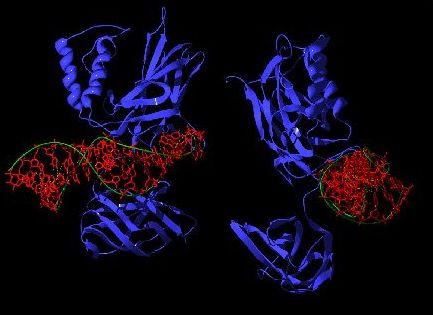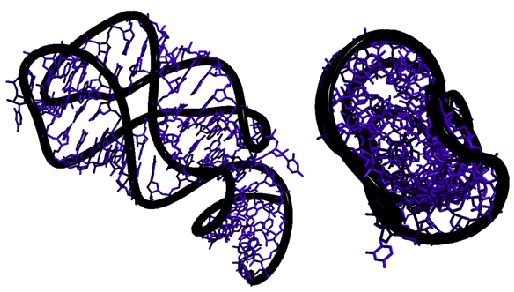Aptamers
Aptamers are oligonucleic acid or peptide molecules that bind to a specific target molecule. They are usually created by selecting them from a large random sequence pool, but natural aptamers also exist in riboswitches. Aptamers can be used for both basic research and clinical purposes as macromolecular drugs. These compound molecules have additional research, industrial and clinical applications.
Nucleic acid aptamers are nucleic acid species that have been engineered through repeated rounds of in vitro selection or equivalently, SELEX (systematic evolution of ligands by exponential enrichment) to bind to various molecular targets such as small molecules, proteins, nucleic acids, and even cells, tissues and organisms. Aptamers are useful in biotechnological and therapeutic applications as they offer molecular recognition properties that rival that of the commonly used biomolecule, antibodies. In addition to their discriminate recognition, aptamers offer advantages over antibodies as they can be engineered completely in a test tube, are readily produced by chemical synthesis, possess desirable storage properties, and elicit little or no immunogenicity in therapeutic applications.

Fig.1. NFkB domain (blue) binding Aptamer (red) based on PDB:1OOA.
Non-modified aptamers are cleared rapidly from the bloodstream, with a half-life of minutes to hours, mainly due to nuclease degradation and clearance from the body by the kidneys, a result of the aptamer,s inherently low molecular weight. Unmodified aptamer applications currently focus on treating transient conditions such as blood clotting, or treating organs such as the eye where local delivery is possible. This rapid clearance can be an advantage in applications such as in vivo diagnostic imaging. An example is a tenascin-binding aptamer under development by Schering AG for cancer imaging. Several modifications, such as 2,-fluorine-substituted pyrimidines, polyethylene glycol (PEG) linkage, etc. (both of which are used in Macugen, an FDA-approved aptamer) are available to scientists with which to increase the serum half-life of aptamers easily to the day or even week time scale.

Fig.2. Adenine Winding Aptamer based on PDB:1Y26.




